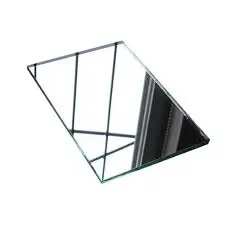

Reflecting on Back-Silvered Mirrors An Artistic and Technological Marvel
The captivating world of mirrors has long fascinated humanity, embodying both practical utility and artistic beauty. Among the various types of mirrors, the back-silvered mirror stands out for its unique construction and the compelling aesthetic it offers. This type of mirror has found its place not just in homes and boutiques but also in the realms of art and design, intersecting technology with creativity.
The Construction of Back-Silvered Mirrors
Back-silvered mirrors, also known as silvered glass mirrors, are produced through a fascinating process that involves the application of a thin layer of silver to one side of a glass substrate. This process typically begins with a smooth, high-quality glass surface. The silver is then deposited onto the back of the glass, often using a vapor deposition technique or through more traditional methods involving chemical reduction. This thin silver film creates a reflective surface capable of bouncing back light, allowing us to see our reflections clearly.
One of the main advantages of back-silvered mirrors is their durability. The silver layer is protected by the glass itself, making these mirrors less prone to damage from scratches or other impacts compared to front-silvered mirrors, where the reflective coating is exposed. Furthermore, the choice of backing material and protective coatings for the silver layer can enhance the longevity and performance of the mirror, making it suitable for a variety of environments, including bathrooms, dressing rooms, and public spaces.
Aesthetic Appeal and Artistic Use
Beyond their functional attributes, back-silvered mirrors offer a unique aesthetic appeal. The layering of glass and silver produces stunning visual effects that can enhance the atmosphere of any space. From modern minimalism to elaborate baroque styles, these mirrors can blend seamlessly with various interior designs, reflecting and amplifying light in ways that enrich the surroundings.
Artists have also embraced the back-silvered mirror as a medium for creative expression. Many contemporary artists incorporate mirrors into their works, using them to explore themes of self-reflection, identity, and perception. The interplay of light and shadow within the mirror creates a dynamic visual experience that invites viewers to engage with the piece on a deeper level. Some artists even manipulate the reflective surface to produce distortions that challenge our understanding of reality and illusion.

Cultural Significance and Symbolism
Mirrors have held significant cultural and symbolic value throughout history. In various traditions, they are seen as tools of self-discovery and introspection. The back-silvered mirror, with its depth and clarity, enhances this symbolism. They serve as metaphors for looking within and confronting one's true self, allowing viewers to engage in a personal exploration of identity.
In different cultures, mirrors have also been associated with magic and mystery. They are often depicted in folklore and mythology as portals to other realms or as objects that reveal hidden truths. The back-silvered mirror, with its reflective surface, undoubtedly carries this mystical allure, making it a powerful object in both art and spirituality.
Technological Advances and Future Trends
As technology progresses, the manufacturing of back-silvered mirrors continues to evolve. Innovations in materials science have led to the development of mirrors with enhanced reflective properties and greater resistance to corrosion and tarnishing. Moreover, the advent of smart mirrors, which integrate digital screens into their design, is revolutionizing the way we interact with reflective surfaces.
The future of back-silvered mirrors is exciting, with possibilities that extend beyond traditional uses. From smart home applications that allow for customizable lighting and interactive displays to artistic installations that push the boundaries of perception, the potential for innovation remains vast.
Conclusion
Back-silvered mirrors represent the intersection of practicality, art, and cultural significance. They remind us not only of the allure of our reflections but also of the deeper questions they prompt about identity and existence. As we gaze into these mirrors, we are invited to reflect on who we are and the world around us, making them an enduring fascination in both our daily lives and the broader canvas of human creativity.